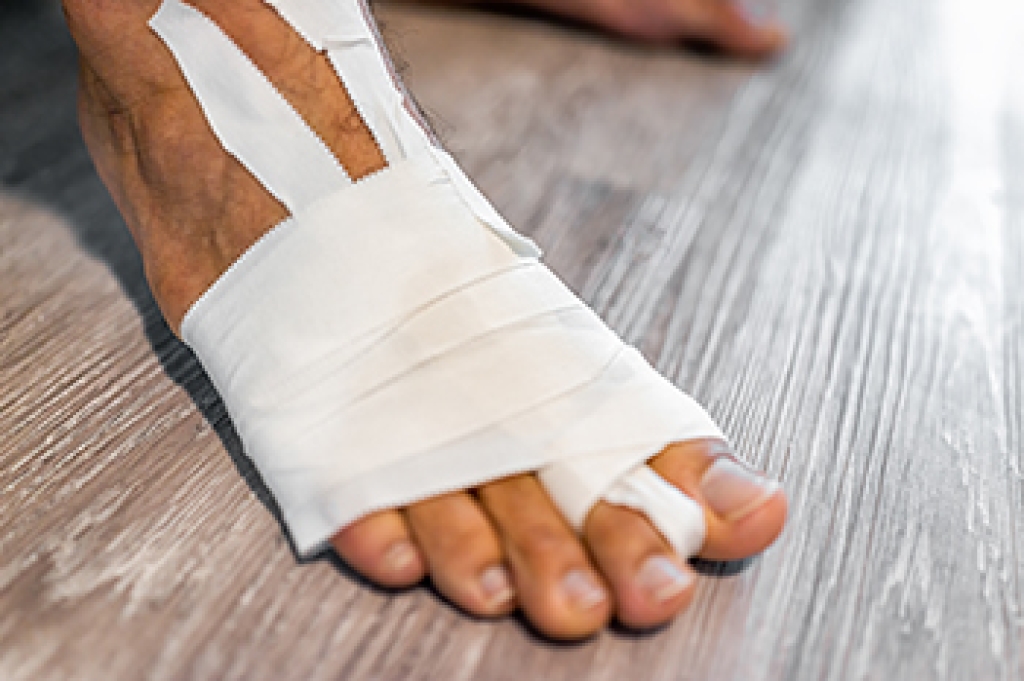Blog
Blog
What a Bunion Is and How It Affects the Foot

A bunion is a foot condition defined by a structural change at the joint where the big toe meets the foot. It appears as a bony prominence along the inside of the foot, often accompanied by swelling or redness. Bunions develop due to abnormal joint mechanics, inherited foot structure, or prolonged pressure from narrow footwear. Over time, the big toe may drift toward the smaller toes, altering normal foot function. Symptoms include joint pain, stiffness, tenderness, and difficulty walking comfortably. A podiatrist can properly diagnose the condition and determine its severity. Treatment may involve shoe recommendations, custom orthotics, joint support, and strategies to reduce inflammation and prevent progression. If you have developed a bunion, it is suggested that you consult a podiatrist who can offer effective management solutions.
If you are suffering from bunion pain, contact One of our podiatrists of Mitchell Foot & Ankle. Our doctors can provide the care you need to keep you pain-free and on your feet.
What Is a Bunion?
Bunions are painful bony bumps that usually develop on the inside of the foot at the joint of the big toe. As the deformity increases over time, it may become painful to walk and wear shoes. Women are more likely to exacerbate existing bunions since they often wear tight, narrow shoes that shift their toes together. Bunion pain can be relieved by wearing wider shoes with enough room for the toes.
Causes
- Genetics – some people inherit feet that are more prone to bunion development
- Inflammatory Conditions - rheumatoid arthritis and polio may cause bunion development
Symptoms
- Redness and inflammation
- Pain and tenderness
- Callus or corns on the bump
- Restricted motion in the big toe
In order to diagnose your bunion, your podiatrist may ask about your medical history, symptoms, and general health. Your doctor might also order an x-ray to take a closer look at your feet. Nonsurgical treatment options include orthotics, padding, icing, changes in footwear, and medication. If nonsurgical treatments don’t alleviate your bunion pain, surgery may be necessary.
If you have any questions, please feel free to contact our office located in Chicago, IL . We offer the newest diagnostic and treatment technologies for all your foot care needs.
How Weight Loss Impacts Foot Structure and Health

Weight loss can have a significant effect on the structure and function of the feet. As body weight decreases, the stress on the arches, joints, and soft tissues of the feet is reduced, which can alleviate pain and improve mobility. Changes in weight can also alter gait and balance, affecting how the feet absorb shock and distribute pressure during walking or exercise. While these changes are often positive, they may also reveal underlying issues such as flat feet, bunions, or joint stiffness that were previously masked by excess weight. A podiatrist can evaluate your foot structure, recommend supportive footwear or custom orthotics, and guide exercises to maintain proper alignment. If you have foot discomfort during or after weight loss, it is suggested that you consult a podiatrist who can offer effective relief solutions.
Obesity has become very problematic at this point in time and can have extremely negative effects on the feet. If you’re an obese individual and are concerned about your feet, contact One of our podiatrists from Mitchell Foot & Ankle. Our doctors can provide the care you need to keep you pain-free and on your feet.
Obesity and Your Feet
Since your feet are what support your entire weight when standing, any additional weight can result in pain and swelling. Being overweight is one of the main contributors to foot complications.
Problems & Complications
Extra Weight – Even putting on just a few extra pounds could create serious complications for your feet. As your weight increases, your balance and body will shift, creating new stresses on your feet. This uneven weight distribution can cause pain, even while doing the simplest tasks, such as walking.
Diabetes – People who are overweight are at serious risk of developing type-2 diabetes, which has a drastic impact on the health of your feet. As you get older, your diabetes might worsen, which could lead to loss of feeling in your feet, sores, and bruises. You could also become more prone to various infections.
Plantar fasciitis – Pressure and stress that is placed on muscles, joints, and tendons can trigger plantar fasciitis, which is an inflammation of tissue that forms along the bottom of the foot.
If you have any questions, please feel free to contact our office located in Chicago, IL . We offer the newest diagnostic and treatment technologies for all your foot care needs.
When the Big Toe Is Pushed Beyond Its Limit

Turf toe occurs when the big toe bends too far upward, stretching or tearing the soft tissues that support the joint. This injury is common in activities that involve sudden stops, quick direction changes, or forceful push offs, especially on firm surfaces. The toe may become painful, swollen, or stiff, and many people notice discomfort when trying to lift off during walking or running. In some cases, the joint feels unstable or weak, making it difficult to move with confidence. Early care helps prevent the injury from worsening and supports a smoother recovery. Resting the toe, avoiding movements that cause pain, and choosing shoes with a stiff sole can reduce stress on the joint. If you experience swelling, tenderness, or difficulty bending the big toe, it is suggested that you schedule an appointment with a podiatrist for proper guidance.
Toe pain can disrupt your daily activities. If you have any concerns, contact One of our podiatrists of Mitchell Foot & Ankle. Our doctors can provide the care you need to keep you pain-free and on your feet.
What Causes Toe Pain?
Most severe toe pain is caused due to a sports injury, trauma from dropping something heavy on the toe, or bumping into something rigid. Other problems can develop over time for various reasons.
Toe pain can be caused by one or more ailments. The most common include:
- Trauma
- Sports injury
- Wearing shoes that are too tight
- Arthritis
- Gout
- Corns and calluses
- Hammertoe
- Bunions
- Blisters
- Ingrown toenails
- Sprains
- Fractures (broken bones)
- Dislocations
When to See a Podiatrist
- Severe pain
- Persistent pain that lasts more than a week
- Signs of infection
- Continued swelling
- Pain that prevents walking
Diagnosis
In many cases the cause of toe pain is obvious, but in others, a podiatrist may want to use more advanced methods to determine the problem. These can range from simple visual inspections and sensation tests to X-rays and MRI scans. Prior medical history, family medical history, and any recent physical traumatic events will all be taken into consideration for a proper diagnosis.
Treatment
Treatments for toe pain and injuries vary and may include shoe inserts, padding, taping, medicines, injections, and in some cases, surgery. If you believe that you have broken a toe, please see a podiatrist as soon as possible.
If you have any questions please contact our office located in Chicago, IL . We offer the newest diagnostic and treatment technologies for all your foot and ankle needs.
Understanding Hairline Fractures in the Foot

A hairline fracture is a very small break in a bone that can cause significant discomfort, even though it may not be obvious at first. Many people notice a gradual increase in pain during walking or standing, especially after repetitive activity. Swelling, tenderness, and mild bruising may appear, and the discomfort often improves with rest but quickly returns with movement. These tiny cracks commonly develop from overuse, wearing improper footwear, or sudden increases in activity levels. Without early attention, the injury can worsen and interfere with mobility. Recognizing the signs promptly helps protect long-term foot health and supports a smoother recovery. If you notice persistent soreness, swelling, or pain that intensifies with activity, it is suggested that you schedule an appointment with a podiatrist for a proper diagnosis and appropriate treatment.
Activities where too much pressure is put on the feet can cause stress fractures. To learn more, contact One of our podiatrists from Mitchell Foot & Ankle. Our doctors can provide the care you need to keep your pain free and on your feet.
Dealing with Stress Fractures of the Foot and Ankle
Stress fractures occur in the foot and ankle when muscles in these areas weaken from too much or too little use. The feet and ankles then lose support when walking or running from the impact of the ground. Since there is no protection, the bones receive the full impact of each step. Stress on the feet can cause cracks to form in the bones, thus creating stress fractures.
What Are Stress Fractures?
Stress fractures occur frequently in individuals whose daily activities cause great impact on the feet and ankles. Stress factors are most common among:
- Runners
- People affected with Osteoporosis
- Tennis or basketball players
- Gymnasts
- High impact workouts
Symptoms
Pain from the fractures occur in the area of the fractures and can be constant or intermittent. It will often cause sharp or dull pain with swelling and tenderness. Engaging in any kind of activity which involves high impact will aggravate pain.
If you have any questions please contact our office located in Chicago, IL . We offer the newest diagnostic and treatment technologies for all your foot and ankle needs.
Blog Archives
- 2026
- 2025

